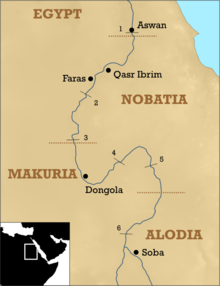Nobatia
Nobatia even Nobadia, Nobatia or Nobadien , was a Christian empire of the eponymous Nobatae ( Nobatae ), since the 4th century. Chr. In sub nubia of in today's northern Sudan are occupied.
The nobads appeared under their names with ancient authors and in their own inscriptions (e.g. those of Silko ). These inscriptions are mostly in Greek , but also in Coptic . From these texts we learn that the nobads were involved in an eternal battle with the Blemmyans . Their capital was Faras . The names of some kings are known who initially saw themselves in the tradition of the Meroitic Empire.
Archeologically, the nobads are identical to the so-called Ballana culture, which is also known as the X group . This culture shows a mixture of Mediterranean and Meroitic elements. Particularly striking are the rich burials (Ballana, Qustul ) under burial mounds , in which animal and human sacrifices were probably also offered.
From the middle of the 6th century, the population of Nobatia converted to Christianity in greater numbers. At the end of the century, the region was conquered or non-violently incorporated into the southern kingdom of Makuria . Nobatia was a province in Makuria until the 14th century. The largest cities were Faras , which received a defensive wall in the Kushite period , and Qasr Ibrim . The latter place, as well as the smaller settlements Kalabsha , Sabagura , Ikhmindi and Sheik Daud were fortified in the 6th century and expanded into small towns. An eparch administered the province.
See also
literature
- Derek A. Welsby : The Medieval Kingdoms of Nubia. Pagans, Christians and Muslims on the Middle Nile. British Museum Press, London 2002, ISBN 0-7141-1947-4 , pp. 16ff.
